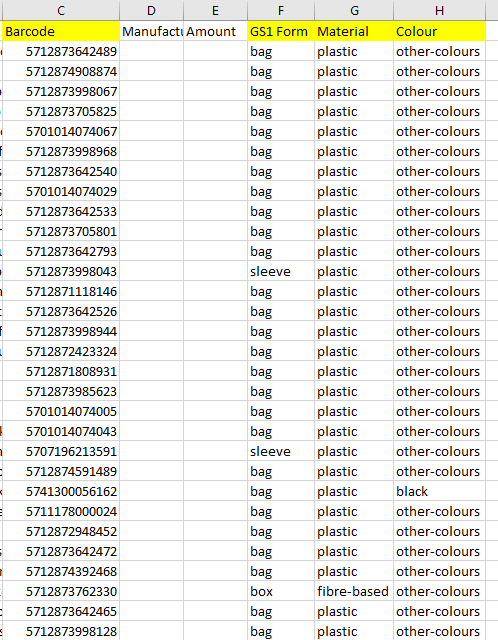Hello everybody. I got data stored in a csv file and the given barcodes and the pictures are labelled with the barcodes. The csv file also contains three columns with categories where the product barcode is labelled with the three categories. I’ve got a picture of the csv for better understanding.
The script runs right now but the loss function is getting more and more negative. And I’m not sure if the approach is correct, I built also my own dataset loader but ended up using the pytorch dataloader.
I would appreciate it if you can give me some tips and advice
Greetings Jonas
import os
abspath = os.path.abspath(__file__)
print(abspath)
import torch
print(f'Do I have GPU? : {torch.cuda.is_available()}') # if True you have gpu which can be used, otherwise not!
import pandas as pd
import numpy as np
import matplotlib.pyplot as plt
import matplotlib.image as mpimg
import os
import torch
import torchvision
import torchvision.transforms as transforms
from PIL import Image
abspath = os.path.abspath(__file__)
print(abspath)
print(os.getcwd())
os.chdir('C:/Users/recykla')
print(os.getcwd())
img_dir = "images/train/"
csv_file = "products.csv"
products = pd.read_csv("products.csv")
# label list
classes = np.unique(products['GS1 Form'])
# Define relevant variables for the ML task
batch_size = 64
num_classes = len(classes)
learning_rate = 0.01
num_epochs = 10
# normalizing data ...
transform = transforms.Compose([transforms.Resize((32,32)),
transforms.ToTensor(),
transforms.Normalize(mean=[0.4914, 0.4822, 0.4465],
std=[0.2023, 0.1994, 0.2010])
])
# Device will determine whether to run the training on GPU or CPU.
# device = torch.device('cuda' if torch.cuda.is_available() else 'cpu')
"""Loading data with PyTorch"""
from torch.utils.data import DataLoader, Dataset
from torchvision.datasets import ImageFolder
import random
import os
def one_hot_encode(labels, num_classes):
one_hot = np.zeros((len(labels), num_classes))
one_hot[np.arange(len(labels)), labels] = 1
return one_hot
class MultiLabelDataset(Dataset):
def __init__(self, img_dir, csv_file, transform=None):
self.dataframe = pd.read_csv(csv_file)
self.img_dir = img_dir
self.img_paths = [str(barcode) + '.jpg' for barcode in self.dataframe['Barcode'].values]
self.labels = {'GS1 Form':self.dataframe['GS1 Form'].values, 'Material':self.dataframe['Material'].values, 'Colour':self.dataframe['Colour'].values}
# dictionary for each class
self.gs1_form = { val:i for i, val in enumerate(list(set(self.labels['GS1 Form'])))}
self.material = { val:i for i, val in enumerate(list(set(self.labels['Material'])))}
self.colour = { val:i for i, val in enumerate(list(set(self.labels['Colour'])))}
self.transform = transform
def __len__(self):
return len(self.img_paths)
def __getitem__(self, idx):
img_path = os.path.join(self.img_dir, self.img_paths[idx])
img = Image.open(img_path).convert('RGB')
label1 = self.gs1_form[self.labels['GS1 Form'][idx]]
label2 = self.material[self.labels['Material'][idx]]
label3 = self.colour[self.labels['Colour'][idx]]
#
label = torch.tensor([label1, label2, label3])
num_classes = len(self.gs1_form) + len(self.material) + len(self.colour)
label = torch.nn.functional.one_hot(label, num_classes = num_classes)
if self.transform:
img = self.transform(img)
return img, label
class MultiLabelDataLoader(DataLoader):
def __init__(self, dataset, batch_size=batch_size, shuffle=False, num_workers=0, pin_memory = False):
super(MultiLabelDataLoader, self).__init__(dataset, batch_size=batch_size, shuffle=shuffle, num_workers=num_workers, pin_memory=pin_memory)
def __iter__(self):
for i, (data, label) in enumerate(super().__iter__()):
yield (data, label)
def __len__(self):
return len(self.dataset)
# Create an instance of the custom dataset class
train_dataset = MultiLabelDataset(img_dir, csv_file, transform=transform)
print(train_dataset[1])
# Create an instance of the custom data loader class
train_loader = DataLoader(train_dataset, batch_size=batch_size, shuffle=True, pin_memory = False)
data_iter = iter(train_loader)
images, labels = next(data_iter)
print(labels)
len(train_loader)
import torch
import torch.nn as nn
import torch.optim as optim
import torch.nn.functional as F
from tqdm import tqdm
# Define the CNN architecture
class Net(nn.Module):
def __init__(self):
super(Net, self).__init__()
self.conv1 = nn.Conv2d(3, 32, 3)
self.conv2 = nn.Conv2d(32, 64, 3)
self.fc1 = nn.Linear(50176, 128)
self.fc2 = nn.Linear(128, 21)
def forward(self, x):
x = self.conv1(x)
x = F.relu(x)
x = self.conv2(x)
x = F.relu(x)
x = x.view(x.size(0), -1)
x = self.fc1(x)
x = F.relu(x)
x = self.fc2(x)
return x
# Initialize the CNN
print(f'Do I have GPU? : {torch.cuda.is_available()}') # if True you have gpu which can be used, otherwise not!
device = torch.device("cuda" if torch.cuda.is_available() else "cpu")
net = Net()
# Define the loss function and optimizer
criterion = nn.MultiLabelSoftMarginLoss()
optimizer = optim.Adamax(net.parameters(), lr=learning_rate)
# data_iter = iter(train_loader)
# images, labels = next(data_iter)
# Train the CNN
for epoch in range(num_epochs):
running_loss = 0
print(running_loss)
for i, (images, labels) in enumerate(tqdm(train_loader, desc=(f'Epoch {epoch + 1}'))):
inputs, labels = images, labels
labels = torch.argmax(labels, dim=1) # Extract class index from one-hot encoded label tensor
optimizer.zero_grad()
outputs = net(inputs)
loss = criterion(outputs, labels)
loss.backward()
optimizer.step()
running_loss += loss.item()
print('Epoch %d loss: %.3f ' % (epoch + 1, running_loss / len(train_loader)))
print('Finished Training')
